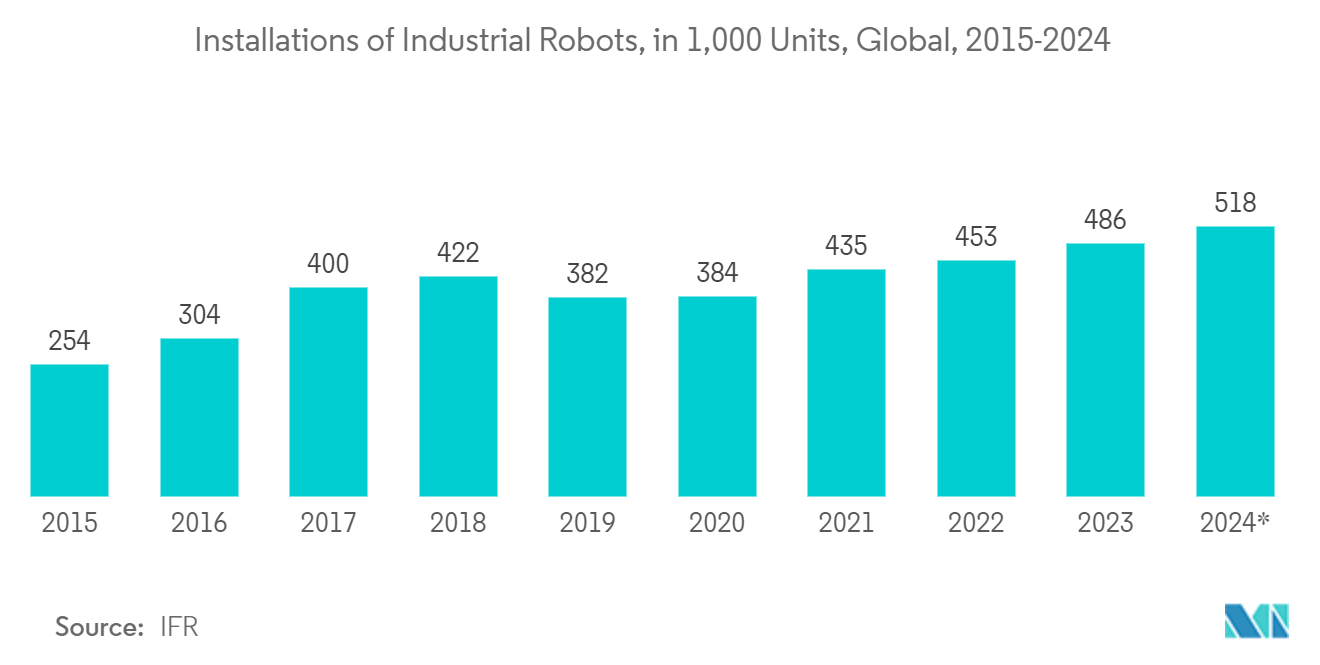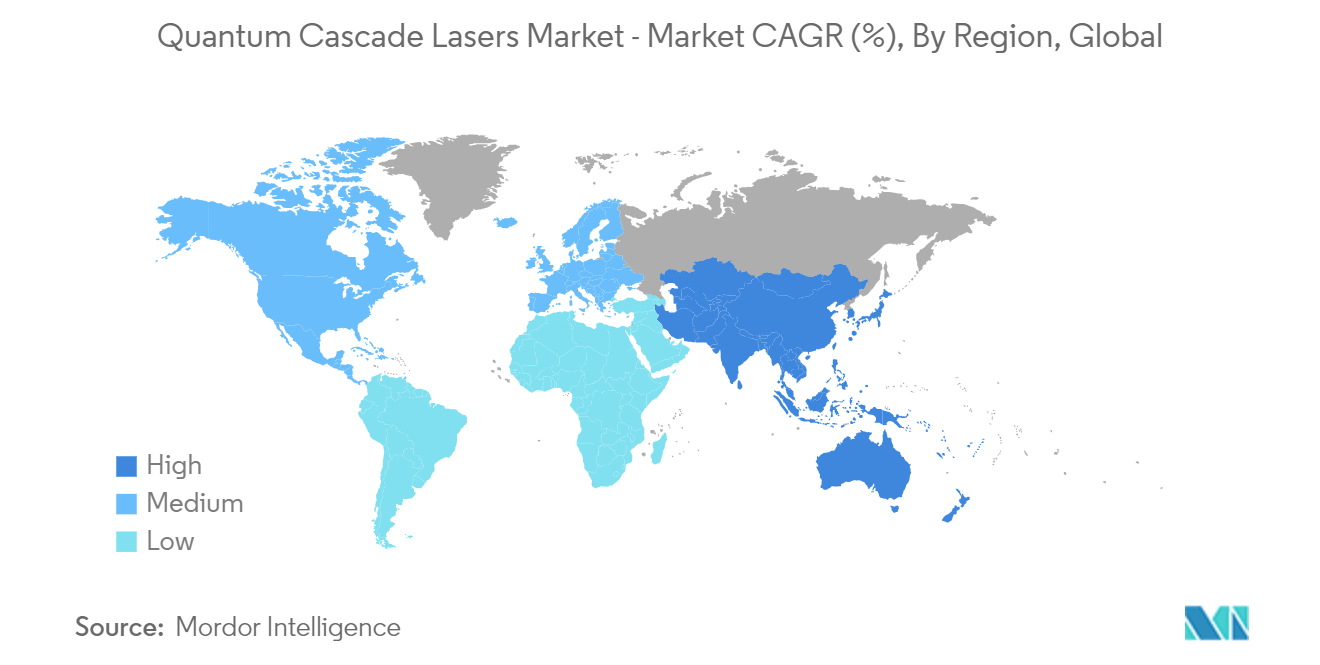Market Trends of Quantum Cascade Lasers Industry
Industrial End-User Industry to Hold Significant Market Share
- QCLs are broadly used in industrial applications due to their high power and brightness, broad wavelength coverage, long-term stability, rapid pulse generation, compactness, solid-state nature, and increased sensitivity and selectivity for gas sensing. QCLs are suitable for industrial environmental monitoring. They help detect and analyze trace gases and pollutants due to their great sensitivity, preciseness, and selectivity. Possibilities exist in areas where QCL-based sensors and systems can improve efficiency, compliance, and environmental sustainability, such as gas sensing, industrial process control, emissions monitoring, and air quality monitoring.
- QCLs monitor air quality in industrial zones. QCL-based sensors can detect and calculate a variety of air pollutants, including particulate case, ozone, nitrogen dioxide, carbon monoxide, and volatile organic compounds. These sensors give constant, real-time data that can be used to examine air quality, identify pollution sources, and perform targeted mitigation actions.
- The emergence of Industry 4.0 has garnered widespread interest among industrialists and process automation industries in the industrial Internet of Things (IIoT) concept. Additionally, a notable rise in demand for industrial environmental monitoring has led to a global boost in the extractive quantum cascade lasers market. The ongoing trend of Industry 4.0 in different sectors has resulted in a considerable surge in the adoption of process automation technologies, especially in emerging economies like China, India, Australia, and South Korea.
- The growing manufacturing sector in several regions globally is likely to aid the market's growth. For instance, China experienced significant growth in its manufacturing sector due to technological advancements, infrastructure development, skilled labor, government policies, and initiatives. According to the National Bureau of Statistics of China, China's industrial production increased by about 4.6% in 2023 compared to 2022.
- The increase in automation in various industries is anticipated to augment the adoption of quantum cascade lasers in factory settings. For instance, according to the IFR forecasts, the global adoption is expected to increase to around 518,000 industrial robots operational across factories all around the globe by 2024. Australia/Asia was the region with the most installed units; an estimated 266,000 units were fitted in 2020 alone. It is estimated that by 2024, industrial robot installations in Asia/Australia will reach 370,000 units. Also, according to IFR, industrial robot shipments are projected to rise significantly in the coming years, surpassing the peak in 2022 when around 453,000 industrial robots were shipped globally.

Asia Pacific Expected to Witness Significant Growth
- China's healthcare and medical sectors are experiencing significant growth, with an increasing focus on advanced diagnostics and treatment. QCLs are used in medical applications such as breath analysis, non-invasive glucose monitoring, and molecular spectroscopy for disease detection and monitoring. The demand for QCLs in these areas is expected to rise as the healthcare sector expands.
- China has been facing an increasing burden of cardiovascular diseases, including heart attack, stroke, coronary artery disease, heart failure, and other conditions, due to dietary & lifestyle changes, rapid urbanization, and industrialization.
- In May 2023, using data from 2,025 hospitals in China, researchers found that air pollution raises the risk of irregular heartbeat. The study included 190,115 patients with acute onset of symptomatic arrhythmia, including atrial fibrillation, atrial flutter, premature beat, and supraventricular tachycardia (a heart condition that causes abnormally fast heart rate). Exposure to air pollution was determined to be linked to an increased risk of irregular heartbeat in an extensive study of 322 Chinese cities.
- Japan is rapidly moving toward "Society 5.0", thus introducing the fifth chapter to the four major stages of human development in this new ultra-smart society. All things are connected through IoT technology, and all technologies are getting integrated, dramatically improving the quality of life.
- Moreover, key sectors coming under this strategy are manufacturing (USD 77.8 million), infrastructure (USD 643.2 million), nursing and medical (USD 55 million), and agriculture (USD 66.2 million). Such expansion in the manufacturing industry further propels the studied market growth.
- The demand for QCLs is likely to propel the Japanese ICT sector owing to the country's investment in the ICT sector. For instance, SoftBank, one of the world's leading telecommunications investment holding companies, recently announced plans to build a large data center in the Japanese city of Hokkaido in 2023. The new data center, which is expected to have a capacity of 40 to 60 million square feet (USD 266 to 400 million), is expected to be one of the largest data centers in Japan.
- The government of South Korea has declared its intention to augment tax incentives associated with research and development and facility investment in the semiconductor industry. This move aims to encourage companies in the sector to invest a minimum of KRW 340 trillion by 2026.
- Furthermore, the government plans to establish a semiconductor engineer training center by 2022 to provide over 150,000 experts for the next decade. These measures are intended to assist South Korean companies in elevating their share in the global non-memory chip market from 3% to 10% by 2030. Such initiatives will drive the industry's growth and create significant demand for QCLs in automation and control systems.

